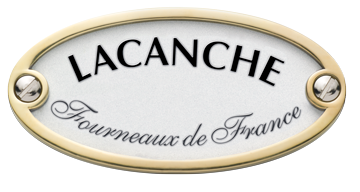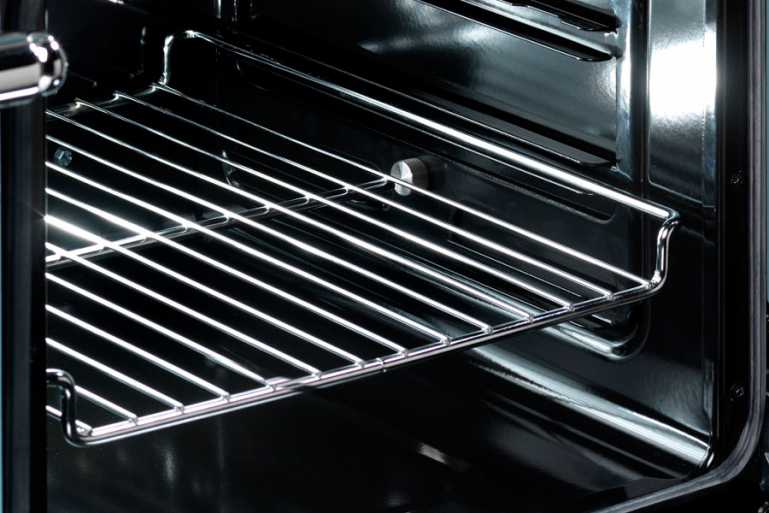Your most frequently asked questions about Lacanche stoves
➤ What is the difference between the “Traditional” and “Classic” top?
The traditional hob top refers to the cast iron plate that sits on the 5kW central gas burner. Similar cast iron plates were often found on old wood stoves in the French countryside. The traditional top gives you the convenience and flexibility of an a planar cooking surface with the heat distributed radially (from center to edge) by the cast-iron. This makes it possible to move each cooking container on this surface and obtain the desired temperature without adjusting the firepower. The center of the plate (the ring) can be removed to access the burner directly and obtain an open flame. Due to its mass of cast iron (12kg), the “traditional plate retains the heat for a very long time and can reposition it even after the burner has been extinguished. Therefore, it is necessary to regulate the power of the flame from the start to control the cooking so as not to have to wait for the cooling. For example, if you want to simmer, it is imperative to adjust the burner to the lowest from the start. The top Classic, he has an open gas burner of 5kW placed under a cast iron grill. S sparkable to other gas burners in the range, this powerful burner is more flexible does not accumulate heat like the traditional top. It is ideal for quickly bringing any container to the desired temperature. On the other hand, it is more difficult to simmer on this burner.
➤ Are your ovens gas or electric or electric convection?
Most of our stoves are available with convection ovens ed electric dual-function, gas furnaces or electric furnaces static. In most models with two ovens, you can choose independently a gas oven and a static electric oven, a gas oven and a two-function electric convection oven, two gas ovens or two electric furnaces (static or dual-function). The convection fan occupies about (75mm) of space at the back of the oven, and as a result, the capacity of the convection oven is lower. The gas furnace typically produces a wet heat, ideal for roasting meats that tend to dry, bake bread or item s not to dry out. Heat flows in the oven by natural convection and rises to the top of the furnace before re descends into the cavity, providing a uniform heat. The gas oven reaches and rises in temperature after loading faster than the electric oven. The electric furnace typically produces a dry heat and is better suited for cooking items requiring drying out (tarts, choux paste, etc.). It also allows lower temperatures than the gas oven. In its bi-function version the electric oven allows a wide variety of cooking. Taking into account the differences between each type of oven, the choice of oven depends on personal preference and should reflect your own style and kitchen personality. Some customers will prefer the reactivity of a gas oven and others the heat constancy of an electric oven. That's why we offer both types of ovens on all our models.
➤ Your electric ovens are available in two versions?
Yes, no electric ovens are available in two versions. Soit as static oven (without fan), either as convection ovens bi-function (static mode or convection mode by switching a switch ). See the question "What is the difference in use between type of furnace" For understand the difference in functioning of our ovens.
➤ Are your ovens equipped with a grill?
The grills are only available with convection ovens or electric static, but our gas ovens can also be used for browning. In electric furnaces, the grill uses the infrared heat of a low-profile heating element as a quick and efficient way to brown the items underneath. The gas oven does not require a grill because natural convection creates a very hot area in the upper part of the oven that can be used as a means of gratinating.
➤ Are ovens self-cleaning?
No, our furnaces do not offer self-cleaning, due to s security issues, energy and reliability wasteful overheating ovens cavities placed below the cooking zone. The interiors are Lacanche oven s are safe, durable and extremely easy to clean thanks to their porcelain finish on durable and non-porous steel. See the question "Cleaning Lacanche ovens". For the simple instructions, ecological and inexpensive cleaning.
➤ How to clean the surfaces of my device?
Enamelled surfaces: As it is a layer of glass and not a paint, our enamelled surfaces are very resistant. Like glass, they can withstand most non-abrasive, acidic, basic and even solvent-based products. But the easiest way is of the first cleaned using a soap dishes (non-abrasive) and hot water, applied with a damp cloth or sponge. Glass products, alcohol or white vinegar also work very well. Handles and Finishes: Do not use abrasive cleaners, acids, chlorinated or basic to clean the handles and finishes, as these may damage them. You can clean them using a dish soap (non-abrasive) and warm water, applied with a damp cloth or sponge. In the case of the brass finish, the use of a polishing paste for copper is possible. Stainless steel cooking surface: Never use chlorinated cleaners to clean stainless steel surfaces. A dishwashing detergent (non-abrasive) and hot water, or a window cleaner applied with a damp cloth or sponge are usually sufficient if the soil is not allowed to accumulate . In case dirt and/or grease deposits have accumulated, it is possible to use a stainless steel pad or an oven cleaner or stainless steel cleaners to remove them. Once rinsed well, finish cleaning with clean water or glass cleaner. If small scratches appear on the stainless steel surfaces, simply repolish them using a dry scrubbing pad (type Scotch Brite green pad) and rub the surface in the polishing direction to make them disappear.
➤ Will I be able to turn on my gas lights if the power supply is turned off?
Yes. Just light the burners with an igniter or a lighter.
➤ Do the gas burners have a night light?
No. Thanks to the independent thermocouple system on each burner, the gas supply is only open when the burner is on. If the burner goes out, the gas supply is automatically interrupted until the burner is restarted by the user.
➤ What can I put in the storage/heating drawers?
Storage drawers under main ovens are ideal for storing utensils and other cookware. Although they do not have a heating element, the drawers are located under the ovens, they can also turn into a warming area for plates, napkins, side dishes, etc. when the ovens are used. For the same reason, never place items in drawers that could melt or burn.
➤ Is the convection function a "true" convection or brewed air?
Yes, it's a "real convection" where a heating element surrounds the fan so that it can heat the air sucked into the oven and incinerate the grease and water particles that carry the odors. This gives a more even cooking, and prevents the cross-contamination of tastes and odors between several dishes as in the case of a pie and a fish.
➤ Does the gas oven have hot spots?
The burner of the gas oven being placed under the oven, the hearth of the gas oven will be hotter than the other walls of the oven. But thanks to the natural convection present in gas ovens, the heat remains uniform in the center of the oven cavity as long as the door is closed. As the heat rises naturally, the upper part of the oven will be hotter and can be used for baking.
➤ Why do some burners take longer to ignite than others?
The mechanical nature of our system, the gas type, altitude, the air inlet, the size of the injector, the position of the igniter, spark resistance and size of the hat Burner are all factors that determine the speed at which each burner ignites. We adjust each burner during the assembly before shipment, but at altitudes greater than 1500 m above sea level, final adjustments onsite burners may be required for optimal performance.
➤ Why do burner caps change color?
The burner caps are made of solid brass, a copper alloy. All the brass used on the Lacanche brand is raw and uncoated . When copper is exposed to oxygen or heat, it tarnishes and changes color. The burners are hats can easily be restored to their original finish. See the section "Cleaning Lacanche burner caps" for more details.
➤ Why do I need ventilation?
Our cookstoves are residential cooking appliances that run on high performance gas. They produce a greater amount of watt (heat) than traditional domestic models and must be used under a canopy hood. In fact the combustion of the gas produces CO, CO2 and other harmful vapors. CO and CO2 move oxygen, can fill your home with harmful vapors that are dangerous for your health. Proper ventilation will also help prevent oil and grease vapors produced during cooking from raining on any flat surface in/near the kitchen.
Cleaning Lacanche ovens
Follow our tips for cleaning your oven.
Download the data sheet:
Follow our tips for Cleaning Planchas.
Download the data sheet:
Follow our tips for cleaning the burner caps.
Download the data sheet:




